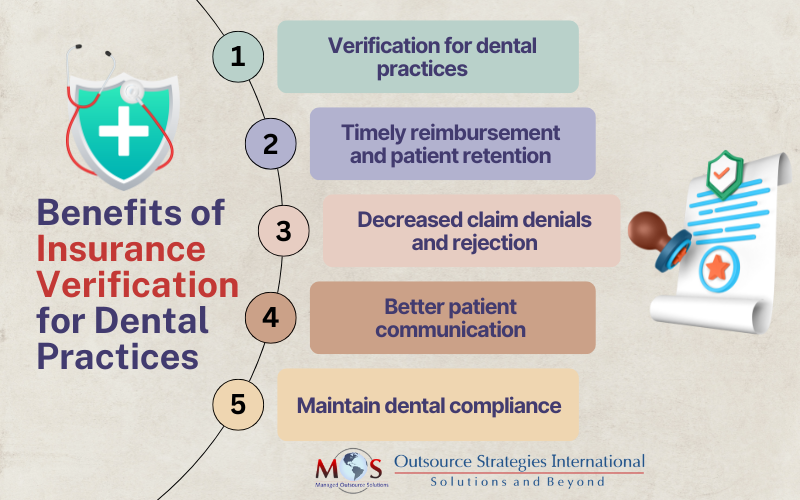Dental practices strive to provide high-quality dental services and exceptional patient care while handling numerous challenges such as patient expectations, technological shifts, staff shortage and other administrative challenges. One crucial challenge when it comes to operational work is the process of dental insurance eligibility verification, which is the primary step to determine whether a patient is covered for the treatment or not. Proactive insurance and coverage verification ensure that both the patient and the dental provider have a clear understanding of the insurance coverage and any associated requirements before treatment begins. This involves verifying the status of their coverage, including active policies and any necessary prior authorizations for a wide range of dental procedures, from routine cleanings to complex surgeries. Any error or delay in dental insurance eligibility verification can hamper patient retention and bring bad reputation for the clinic.
If patients experience multiple issues and need several treatments, coverage details for the dental insurance may end up confusing them and they could face payment issues. This can be resolved if insurance verification is carried out before a patient’s appointment, aimed at documenting their current insurance coverage and understanding the benefits they are entitled to. This process ensures that both the patient and the healthcare provider have a comprehensive understanding of the patient’s insurance status, allowing for smoother and more informed healthcare interactions.
Navigating the complex world of dental insurance eligibility verification is cumbersome since dental plans are riddled with policy restrictions, exclusions, alternate benefits and coverage limitations. Incorrect insurance verification could lead to delayed payments, low collections, increased claim denials and unsatisfied patients. For dental practitioners, these issues pose a threat to their dental practice’s financial standing, disrupting optimized care delivery and reputation of the practice. To mitigate this challenge, practices can hire a dental insurance verification company, so dental practitioners and their staff need not divert valuable time and energy calculating patients’ benefits and claims. Reliable companies can check the eligibility of the patients with the respective insurance companies. This gives healthcare providers clarity regarding the patient’s coverage and payment obligation. This benefits both the dental practices and the patients.
The effectiveness of eligibility verification is the primary determinant of successful billing. In essence, health insurance verification involves the process of contacting an insurance company to ascertain whether a patient possesses active coverage and to validate the legitimacy of the patient’s insurance claims. This crucial step ensures that healthcare providers can accurately bill for the services rendered while also preventing potential issues related to insurance coverage.
Why Is Insurance Verification Central for Dental Practices?
- Analyzing benefit information of the patient prior to providing treatment is very important to avoid claim denials and delays for treatments or services provided to patients. The patient should have active coverage. If the verification is done erroneously, it can lead to delayed payments and claim denials.
- Prior to offering a treatment, it is essential to know whether a particular patient is covered under the scheme.
- Also, dental practices can receive payments for the services rendered. Eligibility verification helps determine the patient’s share of the hospital charges.
- Through dental insurance verification, dental practices can make their patients aware of the costs they could incur for the required treatment, and patients can choose the best course of action using their own discretion.
Benefits of Dental Insurance Verification
As practice expenses and financial challenges increase in the dental field, every penny matters. That’s why it is crucial to have a streamlined insurance verification process to ensure a smooth billing cycle. If any errors occur during the verification process, it could lead to unexpected patient balances, denied claims, and revenue losses for your dental practice.
- Timely reimbursement
When you correctly determine the eligibility of the patient’s insurance benefits for the dental services, you reduce the chance of missed revenue as the claim can be reimbursed in a timely manner. Accurate information collection and verification is the first step towards filing and submitting clear claims. Providing clarity on the financial obligation by verifying plan coverage details ensures attendance and prompt payment from the patient’s side. This improves the cash flow and maximizes revenue for your dental practice.
- Patient retention
It is no surprise that patients prefer practices that are considerate towards their financial responsibility and delivers exceptional care. Surprise bills are a source of stress for patients so when you are upfront about the dental expenses before the treatment is given, the trust in your practice improves greatly. If there are frequent errors in your verification and billing process, it might negatively impact the reputation of your practice and you could end up losing patients as well as drive away new ones.
- Decreased claim denials and rejection
Most claims submissions are preventable and denied or rejected due to inaccuracy in the eligibility process. Verifying insurance coverage plans ensures patient data is accurate and correct claims are submitted to payers. It should also be noted that late claim submission outside of deadline causes denials, therefore fast, efficient, and accurate verification process speeds up the submission process, lowers claim denials and increases steady revenue flow to your practice.
- Better patient communication
Most patients are in the dark when it comes to the specifics of their health plan and often experience difficulties in affording access to healthcare and insurance coverage. You can assist the patient in understanding the full insurance coverage details by breaking down and inspecting benefits, deductibles, scope of covered services, and annual caps. Not only does it increase the trust in your service but you can mitigate any issues that might come up later on after the treatment is carried out. Satisfied, happy patients are the key to building a healthy patient-dental practitioner relationship.
- Maintain dental compliance
A critical aspect while running a dental facility is staying compliant with the legal, regulatory and ethical guidelines that govern the operations. They are established by the state or private payers and other legislative acts including HIPAA and OSHA to assure fair practices, patient safety, integral workplace administration and financial stability. These regulations relate to correct documentation, protocol adherence and periodic training on the updated regulations and policies in your area to build compliance-friendly workplace. Discrepancies or errors while maintaining compliance can lead to risks such as stiff penalties, legal issues, patient dissatisfaction, and financial insecurity for your dental practice.
Some Important Considerations for Dental Insurance Verification
- Determine the effective coverage date
The effective coverage date is the dental insurance coverage start date, it is the day from which the insurance company agrees to provide coverage for the dental treatments performed. While verifying the effective date, it should also be noted that some insurance payers implement a waiting period in their policy. Waiting period refers to a pre-decided time that a patient has to wait before the claims are accepted; any dental procedure or treatment claims submitted before the waiting period is over will be rejected by the insurance payers. This is a critical initial step that should be checked first and foremost.
- Verify their plan’s maximum coverage limit
The annual maximum benefit is the coverage limit imposed by payers in which the maximum amount insurance providers will pay towards patient’s coverage care is fixed for a policy term. For dental insurance, the policy term period is usually a calendar year. Within this term, any dental bills issued once the coverage amount expires have to be paid for by the patient. The maximum amount then resets at the beginning of the next year or term.
It’s essential to examine this, particularly if the patient is approaching this limit. Exceeding the maximum will result in the patient incurring higher out-of-pocket expenses, and it is crucial to have a conversation with the patient about this possibility.
- Find out the patient’s deductible amount
The deductible is the amount the patient has to exhaust from their personal account for dental expenses per plan year before the health plan insurance starts to share for the rest of the covered cost. As the policy term is typically one year, when the new policy period begins the deductible automatically sets to zero so it can significantly impact the patient’s financial responsibility.
Typically, insurance plans feature both an annual deductible per individual and a family deductible. Unfortunately, many patients may not fully grasp the intricacies of their insurance coverage. Hence, it is essential to communicate and clarify their expected financial obligations during the insurance verification process. This not only fosters trust with the patient but also serves to prevent unexpected bills upon completion of their treatment.
- Determine the standard coverage percentage
Coinsurance is the amount expressed in percentage that patients pay after the deductible has been met. It is the share of costs decided between the insurance providers and patient that adds up to 100%. The percentage breakdown is commonly 80/20 split, in which 80% is paid for by the insurer and the remaining 20% by the patient. Health plans mostly completely cover preventive care, but basic care and major care have coinsurance percentages, so it’s necessary that the patient has a clear understanding regarding the amount payers will contribute towards the intended procedure.
- Frequency
The dental procedures may have frequency limitations set upon by the insurance payers per policy period. For example, if a patient has already done two preventive cleaning and is planning for a third before the year is over, it may not be paid for by the plan if it’s restricted to two. So, it’s important to check if the frequency limit exceed for the service.
Review the policy documents to examine this aspect so the patient is empowered to make informed decisions regarding oral care.
- Age Restrictions
Insurance plans typically do not provide coverage for individuals aged 26 and above under their parent’s policy. It’s important to verify whether the patient has reached the age at which they are no longer eligible for coverage through their parent’s insurance.
Additionally, certain procedures may have age-related limitations. For instance, orthodontic benefits may be applicable only until the age of 18, and coverage for fluoride treatments may extend to individuals aged 16 and below. These age-related restrictions can affect the availability of insurance benefits for specific treatments.
- Downgrades
While all these regulations and conditions hold significance, it’s crucial that the patient is informed about a more cost-effective treatment option if it exists. This is where a “downgrade” comes into play, as insurance plans will cover the least expensive procedure among multiple acceptable options. It’s a matter of ensuring the patient is aware of their choices and the associated costs.
If the patient’s insurance is amenable to covering a downgrade, it’s essential to make a record of this during the insurance verification process and present the patient with that alternative. In certain in-network plans, there may even be a requirement for a downgrade document that the patient needs to sign, signifying their consent to opt for the less expensive treatment option.
Consider Hiring a Professional Dental Insurance Verification Company
The policy coverage and terms used in dental insurance are different and trickier when compared to that of standard health insurance. Also, these policies may be handled by a provider other than the primary insurance provider. An average patient may not be able to comprehend complex insurance strategies and it is not advisable to make them spend their valuable time before the customer service representative providing details about their insurance policies. Hiring support staff for insurance verification may not be financially viable and this can negatively impact the patient care offered.
Dental practices will be in poor light if they make a patient undergo a costly dental treatment which is not covered under their scheme as this will harm the patient experience. When insurance verification is handled by dental practices on their own, they might get overwhelmed by the complexity of the task.
Therefore, a better option is to associate with dental insurance verification services that can check the eligibility of the patients with the respective insurance companies. This gives healthcare providers clarity on the patient’s coverage and payment obligation. This benefits both the dental practices and the patients.
Watch your dental practice’s clean claims rise and increase collections!





